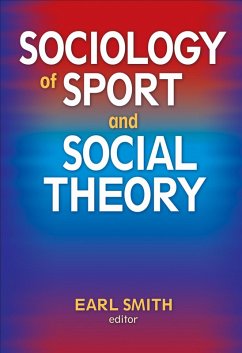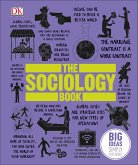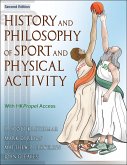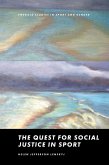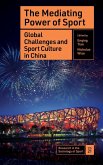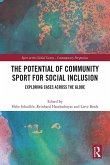Earl Smith
Sociology of Sport and Social Theory
Earl Smith
Sociology of Sport and Social Theory
- Gebundenes Buch
- Merkliste
- Auf die Merkliste
- Bewerten Bewerten
- Teilen
- Produkt teilen
- Produkterinnerung
- Produkterinnerung
Sociology of Sport and Social Theory presents current research perspectives from major sport scholars and leading sociologists regarding issues germane to the sociology of sport while addressing traditional and contemporary sociological theories.
Andere Kunden interessierten sich auch für
![The Sociology Book The Sociology Book]() Sarah TomleyThe Sociology Book16,99 €
Sarah TomleyThe Sociology Book16,99 €![Ethics in Sport Ethics in Sport]() William J J. MorganEthics in Sport106,99 €
William J J. MorganEthics in Sport106,99 €![History and Philosophy of Sport and Physical Activity History and Philosophy of Sport and Physical Activity]() R. Scott KretchmarHistory and Philosophy of Sport and Physical Activity118,99 €
R. Scott KretchmarHistory and Philosophy of Sport and Physical Activity118,99 €![Child Abuse in Sport Child Abuse in Sport]() Mike HartillChild Abuse in Sport110,99 €
Mike HartillChild Abuse in Sport110,99 €![The Quest for Social Justice in Sport The Quest for Social Justice in Sport]() Helen Jefferson Lenskyj (Canada University of Toronto)The Quest for Social Justice in Sport65,99 €
Helen Jefferson Lenskyj (Canada University of Toronto)The Quest for Social Justice in Sport65,99 €![The Mediating Power of Sport The Mediating Power of Sport]() Enqing TianThe Mediating Power of Sport130,99 €
Enqing TianThe Mediating Power of Sport130,99 €![The Potential of Community Sport for Social Inclusion The Potential of Community Sport for Social Inclusion]() The Potential of Community Sport for Social Inclusion154,99 €
The Potential of Community Sport for Social Inclusion154,99 €-
-
-
Sociology of Sport and Social Theory presents current research perspectives from major sport scholars and leading sociologists regarding issues germane to the sociology of sport while addressing traditional and contemporary sociological theories.
Produktdetails
- Produktdetails
- Verlag: Human Kinetics Publishers
- New ed
- Seitenzahl: 264
- Erscheinungstermin: 11. August 2009
- Englisch
- Abmessung: 260mm x 183mm x 23mm
- Gewicht: 706g
- ISBN-13: 9780736075725
- ISBN-10: 0736075720
- Artikelnr.: 26855370
- Herstellerkennzeichnung
- Libri GmbH
- Europaallee 1
- 36244 Bad Hersfeld
- gpsr@libri.de
- Verlag: Human Kinetics Publishers
- New ed
- Seitenzahl: 264
- Erscheinungstermin: 11. August 2009
- Englisch
- Abmessung: 260mm x 183mm x 23mm
- Gewicht: 706g
- ISBN-13: 9780736075725
- ISBN-10: 0736075720
- Artikelnr.: 26855370
- Herstellerkennzeichnung
- Libri GmbH
- Europaallee 1
- 36244 Bad Hersfeld
- gpsr@libri.de
Earl Smith, PhD, is director of American ethnic studies and professor of sociology at Wake Forest University in Winston-Salem, North Carolina. He has over 20 years of experience as an instructor and researcher of topics in sociology of sport, and he has gained recognition as a Rubin Distinguished Professor. He focuses on theintersection of sociological, psychological, and economic theories and empirical research in sport. In 2008, Smith was awarded the North American Society for the Sociology of Sport (NASSS) Book Award. He has also served as president of NASSS. In 2008-2009, the department of anthropology and sociology at Colgate University in Hamilton, New York, presented Smith with the Arnold A. Sio Distinguished Professor of Community and Diversity Award. A former competitive runner, Smith now walks to stay fit and enjoys bird watching and spending time outdoors. He resides in Winston-Salem, North Carolina.
Part I. Great Theorists
Chapter 1. Toward a Sport Ethic: Science, Politics, and Weber's Sociology
Robert Beamish, PhD
Four Pure Types of Action
Science and Ethics: The Limits of Goal-Rational Action
The Politics of Ethical Conduct in Sport
Conclusion
Suggested Research
Additional Sources
Chapter 2. Civilizing Sports: Figurational Sociology and the Sociology of
Sport
Eric Dunning, PhD
The Figurational Sociology of Sport and Its Critics
Criticizing and Testing Elias
The "Civilizing" of Modern Sports
Soccer Hooliganism as an English and World Problem
Conclusion
Suggested Research
Additional Resources
Chapter 3. Beyond the Sociological Imagination: Doing Autoethnography to
Explore Intersections of Biography and History
Nancy Spencer, PhD
Sociological Imagination
Applying the Sociological Imagination to Research
Applying Critical Sociological Imagination to My Studies
Conclusion
Suggested Research
Additional Resources
Part II. Research Guided by Mid-Level Sociological Theories
Chapter 4. The Sociology of Science: Sport, Training, and the Use of
Performance-Enhancing Substances
Ian Ritchie, PhD
Theories in the Sociology of Science
Sport and the Science of Training: The Conservation of Energy and Beyond
Understanding the Use of Performance-Enhancing Substances
Conclusion
Suggested Research
Additional Resources
Chapter 5. Political Economy: Sport and Urban Development
Kimberly S. Schimmel, PhD
Urban Political Economy and Urban Regime Theory
Sport Development and Urban Development in Historical Perspective
Sport, Urban Regime, and Urban Development in Indianapolis
Conclusion
Suggested Research
Additional Resources
Chapter 6. Institutional Logics Theory: Examining Big-Time College Sport
Richard M. Southall, EdD, and Mark S. Nagel, EdD
Theory of Institutional Logics
Case Study: 2007 NCAA Division I Women's Basketball Tournament Broadcasts
Conclusion
Suggested Research
Additional Resources
Chapter 7. Playing for Whom? Sport, Religion, and the Double-Movement of
Secularization in America
David Yamane, PhD, Charles E. Mellies, BA, and Teresa Blake, BA
The Double Movement of Secularization
Societal-Level Secularization: The Differentiation of Sport from Religion
Sport as Civil Religion?
Organizational Innovation Connecting Religion and Sport
Religion and Spirituality at the Individual Level
Conclusion
Suggested Research
Additional Resources
Part III. Theories of Inequality
Chapter 8. Feminist Theory and the Study of Sport: An Illustration from
Title IX
Angela J. Hattery, PhD
The First Wave
Modern Feminist Theory:The Second Wave
Postmodern Feminism: The Third Wave
Title IX and Gender Equity in Intercollegiate Sport
Discussion
Conclusion
Suggested Research
Additional Resources
Chapter 9. Social and Cultural Capital: Race, School Attachment, and the
Role of High School Sports
Rhonda F. Levine, PhD
Theoretical Frameworks
Sport Participation, Academic Achievement and School Attachment
Role of Coaches
Conclusion
Suggested Research Additional Resources
Chapter 10. Race, Class, and Gender Theory: Violence Against Women in the
Institution of Sport
Earl Smith, PhD, and Benny Cooper, BA
The Issue
Methods and Data
Discussion
Conclusion
Suggested Research
Additional Resources
Chapter 11. Masculinities and the Sociology of Sport: Issues and Ironies in
the 21st Century
Bryan E. Denham, PhD
Hegemonic Masculinity
Constructions of Masculinity in Professional Football
Constructions of Masculinity in Hardcore Bodybuilding
Conclusion
Suggested Research
Additional Resources
Chapter 12. Getting Girls in the Game: Negotiations of Structure and Agency
in a Girls' Recreational Sport Program
Cheryl Cooky, PhD
Overview of Theories of Structuration
Culture
Girls in the Game
Cultural Analysis: Discursive Constructions of Sport and the "At-Risk"
Girls
Helping Girls "At-Risk": The Structure of "Girls in the Game"
"Doing Whatever We Want": Reproductive Agency at GIG
Negotiating Agency and Constraint in Everyday Social Interactions: The Role
of Culture in School-Sanctioned Verus Hip-Hop Femininities
Conclusion
Suggested Research
Additional Resources
Part IV. Microlevel Theories
Chapter 13. The Mundanity of Excellence: Tiger Woods and Excellence in Golf
Earl Smith, PhD
Tiger the Golfer
Theory of Dominance in Sport
Discussion
Conclusion
Suggested Research
Additional Resources
Chapter 14. Making it Big: Visible Symbols of Success, Physical Appearance,
and Sport Figures
Bonnie Berry, PhD
The Null Hypothesis and Methodology
Observations of Sport, Fitness, and "Health" Magazine Images
Interpretations: Some Features on Which to Focus
Symbolic Interaction, Dramaturgy, and Image-Making
Conclusion
Suggested Research
Additional Resources
Chapter 15. Sport and Multiple Identities in Postwar Trinidad: The Case of
McDonald Bailey
Roy D. McCree, PhD
Theoretical Considerations
Methodology
Athletic Representation and Multiple Identities: Trinidadian or British
Conclusion
Suggested Research
Additional Resources
Epilogue
References
Index
About the Editor
Chapter 1. Toward a Sport Ethic: Science, Politics, and Weber's Sociology
Robert Beamish, PhD
Four Pure Types of Action
Science and Ethics: The Limits of Goal-Rational Action
The Politics of Ethical Conduct in Sport
Conclusion
Suggested Research
Additional Sources
Chapter 2. Civilizing Sports: Figurational Sociology and the Sociology of
Sport
Eric Dunning, PhD
The Figurational Sociology of Sport and Its Critics
Criticizing and Testing Elias
The "Civilizing" of Modern Sports
Soccer Hooliganism as an English and World Problem
Conclusion
Suggested Research
Additional Resources
Chapter 3. Beyond the Sociological Imagination: Doing Autoethnography to
Explore Intersections of Biography and History
Nancy Spencer, PhD
Sociological Imagination
Applying the Sociological Imagination to Research
Applying Critical Sociological Imagination to My Studies
Conclusion
Suggested Research
Additional Resources
Part II. Research Guided by Mid-Level Sociological Theories
Chapter 4. The Sociology of Science: Sport, Training, and the Use of
Performance-Enhancing Substances
Ian Ritchie, PhD
Theories in the Sociology of Science
Sport and the Science of Training: The Conservation of Energy and Beyond
Understanding the Use of Performance-Enhancing Substances
Conclusion
Suggested Research
Additional Resources
Chapter 5. Political Economy: Sport and Urban Development
Kimberly S. Schimmel, PhD
Urban Political Economy and Urban Regime Theory
Sport Development and Urban Development in Historical Perspective
Sport, Urban Regime, and Urban Development in Indianapolis
Conclusion
Suggested Research
Additional Resources
Chapter 6. Institutional Logics Theory: Examining Big-Time College Sport
Richard M. Southall, EdD, and Mark S. Nagel, EdD
Theory of Institutional Logics
Case Study: 2007 NCAA Division I Women's Basketball Tournament Broadcasts
Conclusion
Suggested Research
Additional Resources
Chapter 7. Playing for Whom? Sport, Religion, and the Double-Movement of
Secularization in America
David Yamane, PhD, Charles E. Mellies, BA, and Teresa Blake, BA
The Double Movement of Secularization
Societal-Level Secularization: The Differentiation of Sport from Religion
Sport as Civil Religion?
Organizational Innovation Connecting Religion and Sport
Religion and Spirituality at the Individual Level
Conclusion
Suggested Research
Additional Resources
Part III. Theories of Inequality
Chapter 8. Feminist Theory and the Study of Sport: An Illustration from
Title IX
Angela J. Hattery, PhD
The First Wave
Modern Feminist Theory:The Second Wave
Postmodern Feminism: The Third Wave
Title IX and Gender Equity in Intercollegiate Sport
Discussion
Conclusion
Suggested Research
Additional Resources
Chapter 9. Social and Cultural Capital: Race, School Attachment, and the
Role of High School Sports
Rhonda F. Levine, PhD
Theoretical Frameworks
Sport Participation, Academic Achievement and School Attachment
Role of Coaches
Conclusion
Suggested Research Additional Resources
Chapter 10. Race, Class, and Gender Theory: Violence Against Women in the
Institution of Sport
Earl Smith, PhD, and Benny Cooper, BA
The Issue
Methods and Data
Discussion
Conclusion
Suggested Research
Additional Resources
Chapter 11. Masculinities and the Sociology of Sport: Issues and Ironies in
the 21st Century
Bryan E. Denham, PhD
Hegemonic Masculinity
Constructions of Masculinity in Professional Football
Constructions of Masculinity in Hardcore Bodybuilding
Conclusion
Suggested Research
Additional Resources
Chapter 12. Getting Girls in the Game: Negotiations of Structure and Agency
in a Girls' Recreational Sport Program
Cheryl Cooky, PhD
Overview of Theories of Structuration
Culture
Girls in the Game
Cultural Analysis: Discursive Constructions of Sport and the "At-Risk"
Girls
Helping Girls "At-Risk": The Structure of "Girls in the Game"
"Doing Whatever We Want": Reproductive Agency at GIG
Negotiating Agency and Constraint in Everyday Social Interactions: The Role
of Culture in School-Sanctioned Verus Hip-Hop Femininities
Conclusion
Suggested Research
Additional Resources
Part IV. Microlevel Theories
Chapter 13. The Mundanity of Excellence: Tiger Woods and Excellence in Golf
Earl Smith, PhD
Tiger the Golfer
Theory of Dominance in Sport
Discussion
Conclusion
Suggested Research
Additional Resources
Chapter 14. Making it Big: Visible Symbols of Success, Physical Appearance,
and Sport Figures
Bonnie Berry, PhD
The Null Hypothesis and Methodology
Observations of Sport, Fitness, and "Health" Magazine Images
Interpretations: Some Features on Which to Focus
Symbolic Interaction, Dramaturgy, and Image-Making
Conclusion
Suggested Research
Additional Resources
Chapter 15. Sport and Multiple Identities in Postwar Trinidad: The Case of
McDonald Bailey
Roy D. McCree, PhD
Theoretical Considerations
Methodology
Athletic Representation and Multiple Identities: Trinidadian or British
Conclusion
Suggested Research
Additional Resources
Epilogue
References
Index
About the Editor
Part I. Great Theorists
Chapter 1. Toward a Sport Ethic: Science, Politics, and Weber's Sociology
Robert Beamish, PhD
Four Pure Types of Action
Science and Ethics: The Limits of Goal-Rational Action
The Politics of Ethical Conduct in Sport
Conclusion
Suggested Research
Additional Sources
Chapter 2. Civilizing Sports: Figurational Sociology and the Sociology of
Sport
Eric Dunning, PhD
The Figurational Sociology of Sport and Its Critics
Criticizing and Testing Elias
The "Civilizing" of Modern Sports
Soccer Hooliganism as an English and World Problem
Conclusion
Suggested Research
Additional Resources
Chapter 3. Beyond the Sociological Imagination: Doing Autoethnography to
Explore Intersections of Biography and History
Nancy Spencer, PhD
Sociological Imagination
Applying the Sociological Imagination to Research
Applying Critical Sociological Imagination to My Studies
Conclusion
Suggested Research
Additional Resources
Part II. Research Guided by Mid-Level Sociological Theories
Chapter 4. The Sociology of Science: Sport, Training, and the Use of
Performance-Enhancing Substances
Ian Ritchie, PhD
Theories in the Sociology of Science
Sport and the Science of Training: The Conservation of Energy and Beyond
Understanding the Use of Performance-Enhancing Substances
Conclusion
Suggested Research
Additional Resources
Chapter 5. Political Economy: Sport and Urban Development
Kimberly S. Schimmel, PhD
Urban Political Economy and Urban Regime Theory
Sport Development and Urban Development in Historical Perspective
Sport, Urban Regime, and Urban Development in Indianapolis
Conclusion
Suggested Research
Additional Resources
Chapter 6. Institutional Logics Theory: Examining Big-Time College Sport
Richard M. Southall, EdD, and Mark S. Nagel, EdD
Theory of Institutional Logics
Case Study: 2007 NCAA Division I Women's Basketball Tournament Broadcasts
Conclusion
Suggested Research
Additional Resources
Chapter 7. Playing for Whom? Sport, Religion, and the Double-Movement of
Secularization in America
David Yamane, PhD, Charles E. Mellies, BA, and Teresa Blake, BA
The Double Movement of Secularization
Societal-Level Secularization: The Differentiation of Sport from Religion
Sport as Civil Religion?
Organizational Innovation Connecting Religion and Sport
Religion and Spirituality at the Individual Level
Conclusion
Suggested Research
Additional Resources
Part III. Theories of Inequality
Chapter 8. Feminist Theory and the Study of Sport: An Illustration from
Title IX
Angela J. Hattery, PhD
The First Wave
Modern Feminist Theory:The Second Wave
Postmodern Feminism: The Third Wave
Title IX and Gender Equity in Intercollegiate Sport
Discussion
Conclusion
Suggested Research
Additional Resources
Chapter 9. Social and Cultural Capital: Race, School Attachment, and the
Role of High School Sports
Rhonda F. Levine, PhD
Theoretical Frameworks
Sport Participation, Academic Achievement and School Attachment
Role of Coaches
Conclusion
Suggested Research Additional Resources
Chapter 10. Race, Class, and Gender Theory: Violence Against Women in the
Institution of Sport
Earl Smith, PhD, and Benny Cooper, BA
The Issue
Methods and Data
Discussion
Conclusion
Suggested Research
Additional Resources
Chapter 11. Masculinities and the Sociology of Sport: Issues and Ironies in
the 21st Century
Bryan E. Denham, PhD
Hegemonic Masculinity
Constructions of Masculinity in Professional Football
Constructions of Masculinity in Hardcore Bodybuilding
Conclusion
Suggested Research
Additional Resources
Chapter 12. Getting Girls in the Game: Negotiations of Structure and Agency
in a Girls' Recreational Sport Program
Cheryl Cooky, PhD
Overview of Theories of Structuration
Culture
Girls in the Game
Cultural Analysis: Discursive Constructions of Sport and the "At-Risk"
Girls
Helping Girls "At-Risk": The Structure of "Girls in the Game"
"Doing Whatever We Want": Reproductive Agency at GIG
Negotiating Agency and Constraint in Everyday Social Interactions: The Role
of Culture in School-Sanctioned Verus Hip-Hop Femininities
Conclusion
Suggested Research
Additional Resources
Part IV. Microlevel Theories
Chapter 13. The Mundanity of Excellence: Tiger Woods and Excellence in Golf
Earl Smith, PhD
Tiger the Golfer
Theory of Dominance in Sport
Discussion
Conclusion
Suggested Research
Additional Resources
Chapter 14. Making it Big: Visible Symbols of Success, Physical Appearance,
and Sport Figures
Bonnie Berry, PhD
The Null Hypothesis and Methodology
Observations of Sport, Fitness, and "Health" Magazine Images
Interpretations: Some Features on Which to Focus
Symbolic Interaction, Dramaturgy, and Image-Making
Conclusion
Suggested Research
Additional Resources
Chapter 15. Sport and Multiple Identities in Postwar Trinidad: The Case of
McDonald Bailey
Roy D. McCree, PhD
Theoretical Considerations
Methodology
Athletic Representation and Multiple Identities: Trinidadian or British
Conclusion
Suggested Research
Additional Resources
Epilogue
References
Index
About the Editor
Chapter 1. Toward a Sport Ethic: Science, Politics, and Weber's Sociology
Robert Beamish, PhD
Four Pure Types of Action
Science and Ethics: The Limits of Goal-Rational Action
The Politics of Ethical Conduct in Sport
Conclusion
Suggested Research
Additional Sources
Chapter 2. Civilizing Sports: Figurational Sociology and the Sociology of
Sport
Eric Dunning, PhD
The Figurational Sociology of Sport and Its Critics
Criticizing and Testing Elias
The "Civilizing" of Modern Sports
Soccer Hooliganism as an English and World Problem
Conclusion
Suggested Research
Additional Resources
Chapter 3. Beyond the Sociological Imagination: Doing Autoethnography to
Explore Intersections of Biography and History
Nancy Spencer, PhD
Sociological Imagination
Applying the Sociological Imagination to Research
Applying Critical Sociological Imagination to My Studies
Conclusion
Suggested Research
Additional Resources
Part II. Research Guided by Mid-Level Sociological Theories
Chapter 4. The Sociology of Science: Sport, Training, and the Use of
Performance-Enhancing Substances
Ian Ritchie, PhD
Theories in the Sociology of Science
Sport and the Science of Training: The Conservation of Energy and Beyond
Understanding the Use of Performance-Enhancing Substances
Conclusion
Suggested Research
Additional Resources
Chapter 5. Political Economy: Sport and Urban Development
Kimberly S. Schimmel, PhD
Urban Political Economy and Urban Regime Theory
Sport Development and Urban Development in Historical Perspective
Sport, Urban Regime, and Urban Development in Indianapolis
Conclusion
Suggested Research
Additional Resources
Chapter 6. Institutional Logics Theory: Examining Big-Time College Sport
Richard M. Southall, EdD, and Mark S. Nagel, EdD
Theory of Institutional Logics
Case Study: 2007 NCAA Division I Women's Basketball Tournament Broadcasts
Conclusion
Suggested Research
Additional Resources
Chapter 7. Playing for Whom? Sport, Religion, and the Double-Movement of
Secularization in America
David Yamane, PhD, Charles E. Mellies, BA, and Teresa Blake, BA
The Double Movement of Secularization
Societal-Level Secularization: The Differentiation of Sport from Religion
Sport as Civil Religion?
Organizational Innovation Connecting Religion and Sport
Religion and Spirituality at the Individual Level
Conclusion
Suggested Research
Additional Resources
Part III. Theories of Inequality
Chapter 8. Feminist Theory and the Study of Sport: An Illustration from
Title IX
Angela J. Hattery, PhD
The First Wave
Modern Feminist Theory:The Second Wave
Postmodern Feminism: The Third Wave
Title IX and Gender Equity in Intercollegiate Sport
Discussion
Conclusion
Suggested Research
Additional Resources
Chapter 9. Social and Cultural Capital: Race, School Attachment, and the
Role of High School Sports
Rhonda F. Levine, PhD
Theoretical Frameworks
Sport Participation, Academic Achievement and School Attachment
Role of Coaches
Conclusion
Suggested Research Additional Resources
Chapter 10. Race, Class, and Gender Theory: Violence Against Women in the
Institution of Sport
Earl Smith, PhD, and Benny Cooper, BA
The Issue
Methods and Data
Discussion
Conclusion
Suggested Research
Additional Resources
Chapter 11. Masculinities and the Sociology of Sport: Issues and Ironies in
the 21st Century
Bryan E. Denham, PhD
Hegemonic Masculinity
Constructions of Masculinity in Professional Football
Constructions of Masculinity in Hardcore Bodybuilding
Conclusion
Suggested Research
Additional Resources
Chapter 12. Getting Girls in the Game: Negotiations of Structure and Agency
in a Girls' Recreational Sport Program
Cheryl Cooky, PhD
Overview of Theories of Structuration
Culture
Girls in the Game
Cultural Analysis: Discursive Constructions of Sport and the "At-Risk"
Girls
Helping Girls "At-Risk": The Structure of "Girls in the Game"
"Doing Whatever We Want": Reproductive Agency at GIG
Negotiating Agency and Constraint in Everyday Social Interactions: The Role
of Culture in School-Sanctioned Verus Hip-Hop Femininities
Conclusion
Suggested Research
Additional Resources
Part IV. Microlevel Theories
Chapter 13. The Mundanity of Excellence: Tiger Woods and Excellence in Golf
Earl Smith, PhD
Tiger the Golfer
Theory of Dominance in Sport
Discussion
Conclusion
Suggested Research
Additional Resources
Chapter 14. Making it Big: Visible Symbols of Success, Physical Appearance,
and Sport Figures
Bonnie Berry, PhD
The Null Hypothesis and Methodology
Observations of Sport, Fitness, and "Health" Magazine Images
Interpretations: Some Features on Which to Focus
Symbolic Interaction, Dramaturgy, and Image-Making
Conclusion
Suggested Research
Additional Resources
Chapter 15. Sport and Multiple Identities in Postwar Trinidad: The Case of
McDonald Bailey
Roy D. McCree, PhD
Theoretical Considerations
Methodology
Athletic Representation and Multiple Identities: Trinidadian or British
Conclusion
Suggested Research
Additional Resources
Epilogue
References
Index
About the Editor

